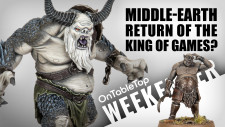Relicblade: Adventure Battle Game
Review: Relic Blade: damn near perfect.
January 17, 2024 by labambaman
This Review Was Edited
Related Review Types
Supported by (Turn Off)
Supported by (Turn Off)
I used to be a gaming journalist. I wrote reviews for magazines and as such have played a lot of different miniatures games in some capacity or another. From being a dedicated member of the community and playing at my local shops with friends, to testing mechanics for reviews, helping playtest games and getting demos at conventions (seriously, never turn down a free demo of something you've never tried before) the number got to somewhere around 40 before I lost track. I lived my life as a journalist with the simple motto of "there's no such thing as the perfect game." Every game, no matter how good, has something about it that drags it back down to reality.
And then I encountered Relic Blade, and that motto got seriously challenged. The creation of one Sean Sutter, it's the closest thing to a perfect wargame I've ever encountered in my 25+ years of being in this hobby.
Relic Blade is a 28mm fantasy skirmish game set in a sort of post apocalyptic fantasy world that's trying to recover from the chaos that was unleashed upon it. There's some staple fantasy races putting in appearances: elves, dwarfs, humans, lizard people, dragon people. But there's also some fun new stuff like the dreaded Battle Pigs, and new twists on classics like the goblins being inspired by arabian fantasy with flying carpets and the likes. It feels fresh and invigorating while being familiar enough to not alienate people terrified of change. The lore is a little scattered and I wish it was more easily accessable since it's not in the rulebook (at least not the copy I have), which is a shame because the lore is really good. Combine that with the beautiful, almost comic styled art and it really paints a great picture.
Rules wise Relic Blade is even more stunning. This is a skirmish game in the truest sense of the word, your average warband will be between four and six models, and while it is possible to go higher by running tons of little guys, the game really works best in that four to six range. It's played on a 2x2 table, meaning that games are quick and violent without a ton of downtime or what feel like wasted turns. I adore this because some games I've played feel like they take forever to get to the action, but by being on a small table Relic Blade is able to get to the meat of the game quickly and leave plenty of room for your peripherals on the table.
Warbands are constructed to a 100 point limit, and different models will have different upgrade card options they can take, letting you not only fill in some dangling points but also tailoring models to your needs. While the upgrade cards use a symbol to say what type they are (weapon, spell, potion, etc.) it's not too terrible, but I have found myself having to double check my rulebook to remember what they mean sometimes. One of the more interesting facets of warband creation is the factions. There's only two: Advocate (good guys) and Adversary (bad guys). There are sort of sub-factions, but they're really more just themed boxes and you can freely mix and match anything from your side together, plus the heaps of new Neutral models the possibilities are open. You can have a warband with a wood elf druid, a goblin sorcerer on a magic carpet, a dragon man cleric and a dwarf berserker and the game just goes "sounds good to me!"
Once you've got your warbands it's time to play. Each model has a stat card, again featuring the beautiful art of Mr. Sutter, which lays out their stats and skills. Every model has three stats: action dice, movement and armor. Action dice are how you actually activate models, and it's a pretty brilliant system. They're basically just points you use to do stuff. Want to move? Spend an AD and move up to the model's move value. Bam, simple. And most models have somewhere between three and six AD, so you have to manage your AD pretty carefully to maximize your activations. You can also use AD to do things like gain a dodge token, or focus to add an extra die to a roll to improve your odds when performing a skill. It seems to simple, but it's so brilliant. It leaves lots of tactical options but also forces you to be careful to not carried away and not have enough AD to do what you wanted to do. And by not forcing players to move before taking actions (honestly, can that design trend just die off already?) you really feel the options given to you.
Skills fall into two main categories: attacks and abilities. Attacks are the primary skill most characters have, but some feature non attack skills that still require the use of AD and rolling to pull them off. Each skill will show a number of dice, which is the number of AD needed to perform the skill, and those dice will show you the minimum result you need to roll to succeed. It's nice and easy to understand, no needless overly complicated nonsense to give a fake illusion of depth, just straight forward and to the point. If you succeed in an attack roll you move on to the damage roll. The attacker rolls a die, and the defender rolls a die (you can get more dice by focusing or having dodge tokens respectively as well as some upgrade cards and abilities) with the attacker adding the damage value of their attack and the defender adding their armor value. If the damage roll is higher than the armor roll, you subtract the two numbers and the difference is how much damage is applied. Again, simple and straight forward with no fiddly bits to slow things down.
When you do attacks you can also score critical hits, and this is one of the areas where I had to re-read the rules a good few times to really get a grasp on it. It's not poorly worded or anything, but it's a lot of numbers being thrown at you at once. Crits come in three flavors: one, two or three dice based on the number of dice being rolled in the attack. If you roll the exact number listed on the attack skill, you score a critical hit. If you rolled a single die, you add +2 to the damage roll, if you score a two dice crit (meaning both dice match the faces shown on the card) you get +1d6 to the damage roll, and if you manage to score a three die crit (meaning you get the exact match to the card and the third die shows one of the faces needed) you get +2d6 to the damage roll. So it's entirely possible, with enough AD and some luck, to end up rolling 3d6 for a damage roll and still adding the damage value of the attack. One shotting models is not as unheard of in this game as it is in some others.
Being taken out of action isn't the end of a model, though. Any model that has been reduced to the final hit box on it's damage track is knocked down and must roll in the recovery phase of the turn to try and stand back up on a roll of 6. So it's possible for guys to get taken down really quickly, but your opponent has to dedicate another action to actually take them out of the game for good. Models also have a crippled mark on their damage track, and once it's hit they get one less AD during their activations.
Relic Blade also features a campaign system, which was a pleasant surprise when I got the rulebook. It's not as complex as something like Burrows & Badgers or Frostgrave, but it does offer a fun experience. And since a game of Relic Blade can realistically be played in 30 minutes, it's possible that a group could dedicate an entire day to playing and play through a whole campaign with ease. The campaign system probably seems shallow and lacking to people more familiar with other games, but I find it offers just enough to give you options without bogging the post game down in a billion dice rolls.
Even the models are beautiful. They have a nice look to them, invoking the style of the artwork, and they're, largely, glorious single piece models. No fiddly construction nonsense, no models with 15 parts for a single man sized dude, even the stuff that is multi-part is limited to two or three parts generally. These are some top tier models with excellent sculpts and beautiful designs. And they aren't overdesigned the hell and back, meaning they paint up real nice and real easy while still having all the necessary detail they need.
If there was any other thing I'd probably say just keeps Relic Blade from perfection, it's the upgrade cards. Don't get me wrong, they're great and offer up a way to change things in a quick and easy way, but some of them feel either super limited or just crazy situational. Some are class specific, but for some of those there's only one model with that class in the game (I'm pretty sure there's only one Cleric and one Geomancer available at time of writing), which makes them feel just a little limited. Others are just way too situational, and can sometimes feel like a waste of points (I had a Cleric with an upgrade that gave him a bonus when crippled, he got dropped in a single shot and never managed to pass a recovery roll). It's not the end of the world, and there's nothing that I can see that feels like a "why is this even in here?" type option, but some stuff does feel a little less impactful than others.
Even with that nitpick, which I had to dig deep to find, Relic Blade is still one of the purest games I've ever experienced. This is a passion project for Mr. Sutter, something he really loves to make, and it shows. Every single aspect is polished and functions wonderfully, and the game just oozes with a charm that a designed by committee game made simply to make a stock price go up ever so slightly can never hope to replicate. Mr. Sutter's love for the game not only makes it a good game, but makes it shine as a beacon of what games can be. This is a true work of art, and it's wild to think a single guy making a game out of his home has come and shown up so many bigger companies with such ease and grace.
If you claim to like fantasy skirmish games, do yourself, and gaming as a whole, a favor and check out Relic Blade. You won't be disappointed.













































Leave a Reply